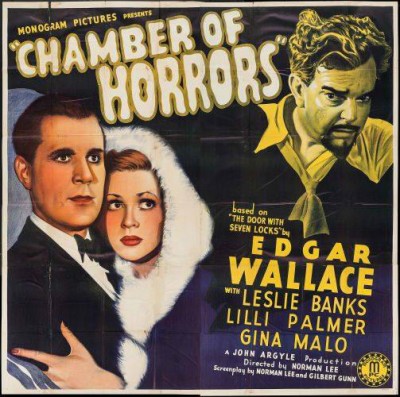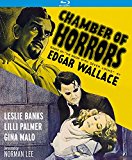| Reviews & Columns |
|
Reviews DVD TV on DVD Blu-ray 4K UHD International DVDs In Theaters Reviews by Studio Video Games Features Collector Series DVDs Easter Egg Database Interviews DVD Talk Radio Feature Articles Columns Anime Talk DVD Savant Horror DVDs The M.O.D. Squad Art House HD Talk Silent DVD
|
DVD Talk Forum |
|
|
| Resources |
|
DVD Price Search Customer Service #'s RCE Info Links |
|
Columns
|
|
|
Chamber of Horrors (The Door with Seven Locks)
Nevertheless, "Edgar Wallace" remained an unusually durable brand long after his demise. Thanks to DVD (and later Blu-ray), viewers are rediscovering not one but two concurrent Edgar Wallace film series, the first made in West Germany, 32 feature films released during 1959-1972, as well as numerous other German and continental thrillers imitative of their style. Meanwhile, Great Britain's Merton Park Studios produced its own successful "Edgar Wallace Mysteries," each typically running just under and hour, between 1960 and 1965, with 47 features.
The handsomely made German films eventually came to be produced in both color and ‘scope, and soon developed a stock company of actors (Joachim Fuchsberger, Eddi Arent, Klaus Kinski, etc.) and directors (Harald Reinl, Alfred Vohrer). In German but set in contemporary Britain, they were usually very slightly campy by design, often making light of English stuffiness and pretention. Most were barely released in the U.S. and inadequately dubbed, but the German DVDs and Blu-rays look great and are very entertaining.
By contrast, the British-made Edgar Wallace movies were more compact, black-and-white crime films, grittier and more character driven. They had lower budgets but were equally good in their own way.
Prior to either of these sets of films had been adaptations of Wallace's stories from the silent era into the 1940s, the best remembered (owing more to its public domain status than the film itself) being The Dark Eyes of London (1939). Starring Bela Lugosi. The film was renamed The Human Monster by U.S. distributor Monogram, which did so well with the picture they soon signed the actor to a multi-film contract.
Another Monogram release in the U.S., the British-made Chamber of Horrors (1940) is actually The Door with Seven Locks, an all-sizzle, no-steak almost horror-mystery starring Leslie Banks and Lilli Palmer. It has better acting and production values than Monogram's usual fare but none of the entertaining silliness.
The movie opens in dramatic, dark and stormy night fashion, with Lord Charles Francis Selford (Aubrey Mallalieu) on his deathbed, bidding farewell to his 11-year-old heir, John (Ross Landon), who has a disfigured, useless arm. As the servants and various other characters look on, including physician Dr. Manetta (Leslie Banks), the family jewels are locked away in the family crypt, requiring seven separate keys to open it.
Years later, a dying man named Silva (JH Roberts) messages one of the keys to another heir, June Lansdowne (Lilli Palmer). She visits the man in hospital, but is terrorized by a nurse (Cathleen Nesbitt), actually one of Lord Selford's ex-servants. She contacts the police, but all traces of the working hospital and its staff vanish. With detective-boyfriend Dick Martin (Romilly Lunge) and wisecracking American friend Glenda Baker (Gina Malo) in tow, June confers with Selford's banker, Edward Havelock (David Horne), who's shocked to discover the keys held in his trust are missing.
Chamber of Horrors shares the same iconography of the later Edgar Wallace films, and is reasonably entertaining but not particularly memorable and definitely not a horror film. However, the picture is well acted by an interesting cast. Banks, with his half-paralyzed face (the result of battle during WWI) was already an established screen menace, best known for The Most Dangerous Game (1932). Lilli Palmer, of course, went on to greater acclaim and a long screen career, but her co-star, Romilly Lunge, is equally appealing yet after six years in British films called it quits after this, even though he lived until 1994.
Horne and Nesbitt were familiar faces to British audiences, Nesbitt also in later Hollywood films like An Affair to Remember, Family Plot, and Julia.
Cincinnati-born Gina Malo is one of those expat Americans working abroad whose life story would make a more interesting film than this. She began her career on Broadway, masquerading as a French film star to secure roles in high-profile operettas and musicals. She had a fine voice, but her ruse apparently discovered, she fled to Britain, where she became popular on both the stage and in films. She's quite good here, like a dialed-back Patsy Kelly.
Video & Audio
Filmed in black-and-white for 1.37:1 projection, Chamber of Horrors looks quite grainy and never particularly impressive, though adequate. The too-short opening titles use a font that may not have been original, as its design looks more like something that might have been used for television much later. Conversely, the film otherwise seems to be the longer (by about 10 minutes) British version. Audio is adequate and English subtitles are offered on this region "A" disc.
Extra Features
The lone supplement is an audio commentary by the prolific (though often frustrating) David Del Valle, here accompanied by filmmaker Kenneth J. Hall.
Parting Thoughts
Not great but worthwhile for fans of the later Edgar Wallace movies and, peripherally, classic horror fans, Chamber of Horrors is mildly Recommended.
Stuart Galbraith IV is the Kyoto-based film historian largely absent from reviewing these days while he restores a 200-year-old Japanese farmhouse.
|
| Popular Reviews |
| Sponsored Links |
|
|
| Sponsored Links |
|
|
| Release List | Reviews | Shop | Newsletter | Forum | DVD Giveaways | Blu-Ray | Advertise |
|
Copyright 2024 DVDTalk.com All Rights Reserved. Legal Info, Privacy Policy, Terms of Use,
Manage Preferences,
Your Privacy Choices | |||||||














